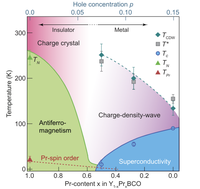Publication Date: July 17, 2023
Authors: Mingu Kang, Chao C. Zhang, Enrico Schierle, Stephen McCoy, Jiarui Li, Ronny Sutarto, Andreas Suter, Thomas Prokscha, Zaher Salman, Eugene Weschke, Shane Cybart, John Wei (CQIQC Member),and Riccardo Comin
Abstract:
Copper oxide superconductors universally exhibit multiple forms of electronically ordered phases that break the native translational symmetry of the CuO2 planes. In underdoped cuprates with correlated metallic ground states, charge/spin stripes and incommensurate charge density waves (CDWs) have been experimentally observed over the years, while early theoretical studies also predicted the emergence of a Coulomb-frustrated ‘charge crystal’ phase in the very lightly doped, insulating limit of CuO2 planes. Here, we search for signatures of CDW order in very lightly hole-doped cuprates from the 123 family RBa2Cu3O7 − δ (RBCO; R: Y or rare earth), by using resonant X-ray scattering, electron transport, and muon spin rotation measurements to resolve the electronic and magnetic ground states fully. Specifically, Pr is used to substitute Y at the R-site to systematically suppress the superconductivity and access the extremely low hole-doping regime of the cuprate phase diagram without changing the oxygen stoichiometry. X-ray scattering data taken on Pr-doped YBCO thin films reveal an in-plane CDW order that follows the same linear evolution of wave vector versus hole concentration as oxygen-underdoped YBCO but extends all the way to the insulating and magnetically ordered Mott limit. Combined with the recent observation of charge crystal phase on an insulating surface of Bi2Sr2CaCu2O8 + z, our results in RBCO suggest that this electronic symmetry breaking is universally present in very lightly doped CuO2 planes. These findings bridge the gap between the Mott insulating state and the underdoped metallic state and underscore the prominent role that Coulomb-frustrated electronic phase separation plays among all cuprates.
Related links

